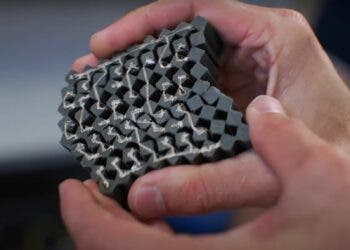
Flexible electronics are still in their infancy, however scientists have raved about them for years now. Electronics that can bend and stretch a lot without breaking open up a slew of new possibilities, from smart clothing equipped with all kinds of sensors to flexible micro-devices. Recently, researchers at the Swiss Federal Institute of Technology (ETH) made a great leap forward in turning flexible electronics into a practical application after they successfully made stretchy electronics by embedding delicate circuits into a flexible surface that can be stretched three times its normal length.
The researchers drew their inspiration from nature, namely from the way tendons connect to bones. Electronic circuits are very fragile and when subjected to bending on a flexible board, they break easily. Finding a balance between the two is far from being an easy task.
You have two materials with very different mechanical properties,” Andre Studart, a researcher at the Swiss Federal Institute of Technology in Zurich, told Reuters. “The challenge is to bridge these different properties.”
The scientists tackled the issue by developing a novel surface that has both stiff, used to harbor the electronics, and flexible regions – like tiny islands. The material employed is polyurethane, the same substance used in skateboard wheels and floor coating. The soft part can stretch by 350 percent, while the electronics are safe from bending and torsion as they sit on a stiff surface, created by impregnating the material with tiny platelets of aluminium oxide and a synthetic clay called laponite.
Islands of circuits
If you know a thing or two about strength of materials, you might wonder how the junction points between the stiff and flexible parts of the new sheet do no break. The researchers overcame this hurdle by applying multiple layers to comprise the sheet that incrementally become stiffer from bottom to top.
To illustrate their research, the scientists added LED circuits on the stiff islands. The LEDs stayed lit even when the sheet was stretched to 150 percent of its length.
The research findings are set to hit the commercial market quite earlier than thought, since MC10 Inc, a Massachusetts-based start-up born out of research by John Rogers and his team at the University of Illinois, is already planning on delivering products based on stretchable electronics. One of their feature products is a sensor-laden, flexible skullcap that monitors impacts to the head during sport, which was developed in cooperation with Reebok and is expected to go on sale next year.
A more interesting stretchy electronics device, however, is a balloon catheter with built-in electronic sensors for heart patients, which researchers plan to start testing on people in the next year or so. Balloon catheters are regularly used by surgeons to unclog arteries “but those balloon catheters do not have any active surgical power,” says John Rogers, a materials scientists at the University of Illinois in Urbana-Champaign. “They are just dumb mechanical instruments.”
The device developed by Rogers’ company can monitor features such as temperature, pressure, blood flow and electrical activity, and can also remove damaged tissue.
The present research, who’s findings were detailed in the journal Nature Communications, isn’t the only one to report success with flexible electronics, however. In the past we’ve written about how University of Pennsylvania researchers made flexible electronic circuits out of nanocrystals or how a novel coating technique allowed for the manufacturing of the first entirely plastic solar cell.






